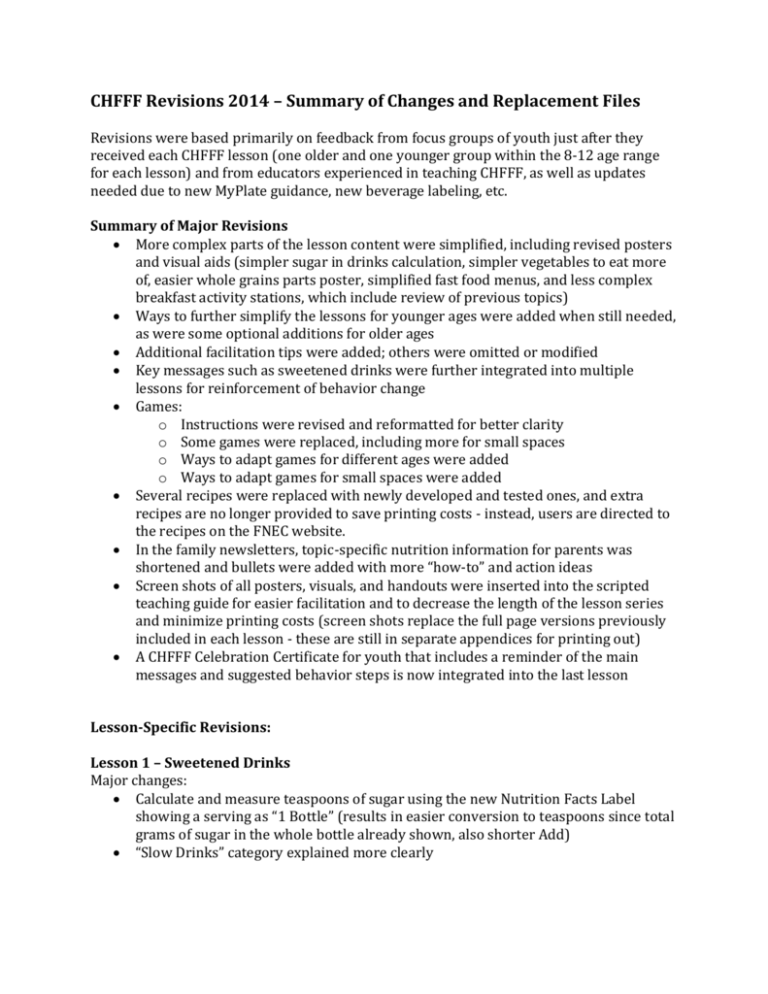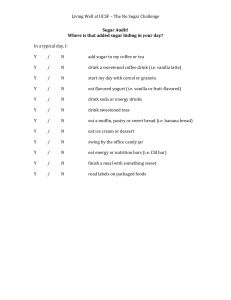CHFFF Revisions 2014 – Summary of Changes and Replacement
advertisement

CHFFF Revisions 2014 – Summary of Changes and Replacement Files Revisions were based primarily on feedback from focus groups of youth just after they received each CHFFF lesson (one older and one younger group within the 8-12 age range for each lesson) and from educators experienced in teaching CHFFF, as well as updates needed due to new MyPlate guidance, new beverage labeling, etc. Summary of Major Revisions More complex parts of the lesson content were simplified, including revised posters and visual aids (simpler sugar in drinks calculation, simpler vegetables to eat more of, easier whole grains parts poster, simplified fast food menus, and less complex breakfast activity stations, which include review of previous topics) Ways to further simplify the lessons for younger ages were added when still needed, as were some optional additions for older ages Additional facilitation tips were added; others were omitted or modified Key messages such as sweetened drinks were further integrated into multiple lessons for reinforcement of behavior change Games: o Instructions were revised and reformatted for better clarity o Some games were replaced, including more for small spaces o Ways to adapt games for different ages were added o Ways to adapt games for small spaces were added Several recipes were replaced with newly developed and tested ones, and extra recipes are no longer provided to save printing costs - instead, users are directed to the recipes on the FNEC website. In the family newsletters, topic-specific nutrition information for parents was shortened and bullets were added with more “how-to” and action ideas Screen shots of all posters, visuals, and handouts were inserted into the scripted teaching guide for easier facilitation and to decrease the length of the lesson series and minimize printing costs (screen shots replace the full page versions previously included in each lesson - these are still in separate appendices for printing out) A CHFFF Celebration Certificate for youth that includes a reminder of the main messages and suggested behavior steps is now integrated into the last lesson Lesson-Specific Revisions: Lesson 1 – Sweetened Drinks Major changes: Calculate and measure teaspoons of sugar using the new Nutrition Facts Label showing a serving as “1 Bottle” (results in easier conversion to teaspoons since total grams of sugar in the whole bottle already shown, also shorter Add) “Slow Drinks” category explained more clearly For a 20 oz cola, 16 teaspoons sugar, not 17, is used – this is more accurate and in line with the grams of sugar listed on the new full-bottle Nutrition Facts Label.1 Correction: Recommended amount of 100% juice per day for 7-18 year olds is 8-12 ounces, which is 1 to 1 ½ cups, not ¾ cup (previous mistake in converting ounces to cups). Greater emphasis that only “Stop” drinks should be used in the Apply (and none with fruit or dairy since then sugar includes fructose or lactose and not just added sugar) Revised 1-V-1 Station Instructions for measuring sugar in drinks - New file is 1 page, and includes both instructions and table to convert sugar in grams to teaspoons (shorter, since columns for different servings sizes no longer needed); also omitted “How Much Sugar?” poster since no longer needed since math is now more simple (just divide by 4 for whole container, instead of also having to deal with number of servings). Revised Poster 1-1 Read the Label: 20 Ounce Cola! – The Nutrition Facts Label is now for a “1 Bottle” serving. Lesson 2 – Vegetables and Fruits Major changes are: New title “Color Your Plate!” instead of “Eat a Rainbow” – We found that the “rainbow” visual took away from the Dietary Guidelines and MyPlate messages to focus specifically on dark green, red and orange vegetables. Shortened the Anchor by having educators read the descriptors. Now introduce MyPlate (with a newly created poster), all of its food groups, and the “make half your plate veg/fruit message” all at the beginning of the Add, instead of doing the half-plate veg/fruit sorting activity we had before. The “orange” vegetable group is now “red and orange” as in MyPlate and the 2005 Dietary Guidelines. Simplified the vegetable groups discussion by not mentioning “starchy” and “other” but just saying that lots of other vegetables are also healthy. Replaced the Vegetable Category Signs to post with a new “Try More of These!” poster emphasizing the 3 vegetable groups to eat more of. Clarified better the educator instructions for the Apply activity where kids add vegetables and fruits to a day of meals and snacks using Dairy Council food cards. Replaced the Orange and White Fries, which required baking, with Southwestern Black Bean Salad. Replaced the “Garden Salad with Vinaigrette” with “Low-Fat Ranch Dressing for Salad,” since the vinaigrette was not well-liked by youth. The recipe is just for the dressing, since including both the salad and dressing together in the recipe and NFL did not meet our recipe guidelines (this way it is a condiment, not a main dish). 1 We got 17 tsp in earlier version because we first converted to teaspoons per serving, then rounded that up to 7 since closer than 6, then multiplied by 2.5 servings, and rounded that up to 17 since closer than 16. But when you convert total grams per whole bottle to teaspoons, it is closer to 16 than 17. Replaced first healthy step suggestion with “Eat a vegetable at lunch!” since this is important and should be available via school lunch, and previous “Eat fruit at breakfast” is already in Lesson 6 Healthy Steps. Lesson 3 – Label Reading Major changes are: Added scanned food packages to Supply List and to lesson Simplified introductory discussion of the food label in the Add In the Apply, added suggestions to help kids line up more easily Other minor editing; no replacement files other than lesson. Lesson 4 – Whole Grains Major changes are: Shortened and simplified the Add explaining whole grains Developed a new poster to more simply show the processing of whole grains to refined grains – it shows the entire grain with the 3 parts and replaces the three separate pieces in the original version (easier to use, and no endo-“sperm” comments) Omitted the Whole Grain Ingredients poster (not needed, lesson now simplified) In the Apply, added suggestions to help kids line up more easily Modified the second Healthy Step suggestion to “Choose whole grain bread instead of white bread” Added scanned food packages to Supply List and to lesson Added an additional scanned grain package with label, so 16 total and easier to make two teams Lesson 5 – Fast Foods Major changes: In the portion size poster (“Big or Small?”), the two sizes of hot dogs were replaced with a cup of water and a small and a large cup of soda to reinforce the sweetened drinks message in Lesson 1 and emphasize healthy fast food choices In the second Apply, the fast food menus were simplified, with several main item choices and several side dish choices, with photos of the actual food item next to each choice. Youth are asked to choose one of each rather than a more open-ended selection process (younger groups can just choose a main item) Lesson 6 – Breakfast Major changes: Shortened and simplified wording in the Add A brief review of Go, Slow and Stop drinks was added In the Apply, the breakfast convenience foods station was simplified to just compare two sets of similar items (waffles and cereal bars), and the fast food breakfast station (which was too complex) was replaced with a sweetened drinks sorting activity using Dairy Cards and a newly created Glass of Water card The Breakfast Olympics Score Card was revised for these new stations 4 new scanned food packages were added for the convenience food station Modified the second Healthy Step suggestion to “Eat three food groups at breakfast” since families would not know what a “wild card breakfast” was A CHFFF Celebration Certificate is now included Replaced the Quick Fruit Scones, which required baking, with Top Your Own Oatmeal







